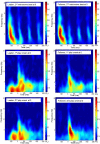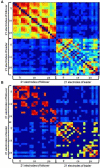Intra- and interbrain synchronization and network properties when playing guitar in duets
- PMID: 23226120
- PMCID: PMC3509332
- DOI: 10.3389/fnhum.2012.00312
Intra- and interbrain synchronization and network properties when playing guitar in duets
Abstract
To further test and explore the hypothesis that synchronous oscillatory brain activity supports interpersonally coordinated behavior during dyadic music performance, we simultaneously recorded the electroencephalogram (EEG) from the brains of each of 12 guitar duets repeatedly playing a modified Rondo in two voices by C.G. Scheidler. Indicators of phase locking and of within-brain and between-brain phase coherence were obtained from complex time-frequency signals based on the Gabor transform. Analyses were restricted to the delta (1-4 Hz) and theta (4-8 Hz) frequency bands. We found that phase locking as well as within-brain and between-brain phase-coherence connection strengths were enhanced at frontal and central electrodes during periods that put particularly high demands on musical coordination. Phase locking was modulated in relation to the experimentally assigned musical roles of leader and follower, corroborating the functional significance of synchronous oscillations in dyadic music performance. Graph theory analyses revealed within-brain and hyperbrain networks with small-worldness properties that were enhanced during musical coordination periods, and community structures encompassing electrodes from both brains (hyperbrain modules). We conclude that brain mechanisms indexed by phase locking, phase coherence, and structural properties of within-brain and hyperbrain networks support interpersonal action coordination (IAC).
Keywords: EEG hyperscanning; cortical phase synchronization; functional connectivity; graph theory; joint action; music; social interaction.
Figures











References
-
- Babiloni F., Astolfi L., Cincotti F., Mattia D., Tocci A., Tarantino A., et al. (2007a). Cortical activity and connectivity of human brain during the prisoner's dilemma: an EEG hyperscanning study, in Engeneering in Medicine and Biological Society 2007. EMBS 2007. 29th Annual International Conference of the IEEE (Lyon, France: ). 10.1109/IEMBS.2007.4353452 - DOI - PubMed
-
- Babiloni F., Cincotti F., Mattia D., De Vico Fallani F., Tocci A., Bianchi L., et al. (2007b). High resolution EEG hyperscanning during a card game, in Engeneering in Medicine and Biological Society 2007. EMBS 2007. 29th Annual International Conference of the IEEE (Lyon, France: ). 10.1109/IEMBS.2007.4353453 - DOI - PubMed
-
- Basar-Eroglu C., Basar E., Demiralp T., Schurmann M. (1992). P300-response: possible psychophysiological correlates in delta and theta frequency channels. A review. Int. J. Psychophysiol. 13, 161–179 - PubMed
LinkOut - more resources
Full Text Sources

